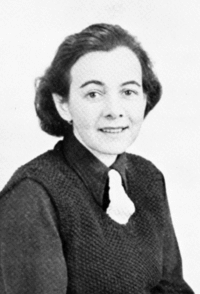

Karin Boye
| |
|---|---|

Karin Boye in the 1940s
| |
| Native name |
Karin Maria Boye
|
| Born | (1900-10-26)26 October 1900 Gothenburg, Sweden |
| Died | 21 April 1941(1941-04-21) (aged 40) Alingsås, Sweden |
| Resting place | Östra kyrkogården, Gothenburg |
| Language | Swedish |
| Nationality | Swedish |
| Period | 1 |
| Genres | novel, poetry, essay |
| Years active | 1922–1941 |
| Notable works | "Yes, of course it hurts", Kallocain |
| Spouse | Leif Björk (1929–1932) |
| Partner | Margot Hanel (1934–1941) |
| Signature | |
| Website | |
| www | |
Karin Maria Boye (listenⓘ; 26 October 1900 – 24 April 1941)[1] was a Swedish poet and novelist. In Sweden, she is acclaimed as a poet, but internationally, she is best known for the dystopian science fiction novel Kallocain (1940).

Boye was born in Gothenburg (Göteborg), Sweden in a wealthy family and moved with her family to Stockholm in 1909, eventually settling in a house in Huddinge. In Stockholm, she studied at the Åhlinska skolan until 1920. She then attended Södra seminariet, a teacher-training programme, in order to become a school teacher. She studied at Uppsala University from 1921 to 1926 and debuted in 1922 with a collection of poems, "Clouds" (Swedish: Moln). During her time in Uppsala and until 1930, Boye was a member of the Swedish Clarté League, a socialist group that was strongly antifascist.[2] She was also a member of the women's organization Nya Idun.[3]
In 1931, Boye, together with Erik Mesterton and Josef Riwkin, founded the poetry magazine Spektrum, introducing T. S. Eliot and the Surrealists to Swedish readers. She translated many of Eliot's works into Swedish; she and Mesterton translated "The Waste Land".[2]
Boye is perhaps most famous for her poems, the most well-known of which are "Yes, of course it hurts" (Swedish: Ja visst gör det ont)[4] and "In motion" (I rörelse) from her collections of poems "The Hearths" (Härdarna), 1927, and "For the sake of the tree" (För trädets skull), 1935. She was also a member of the Swedish literary institution Samfundet De Nio (The Nine Society) from 1931 until her death in 1941.
Boye's 1931 novel Astarte was a criticism of the bourgeois culture, and won a Nordic novel prize. Her novel "Crisis" (Kris) depicts her religious crisis and lesbianism. In her novels "Merit awakens" (Merit vaknar) and "Too little" (För lite) she explores male and female role-playing.[2]
Outside Sweden, her best-known work is probably the novel Kallocain. Inspired by her visit to Germany during the rise of Nazism, it was a portrayal of a dystopian society in the vein of George Orwell's Nineteen Eighty-Four and Aldous Huxley's Brave New World (though written almost a decade before Orwell's magnum opus). In the novel, an idealistic scientist named Leo Kall invents Kallocain, a kind of truth serum. The novel was filmed in Sweden in 1981 and was the main influence on the movie Equilibrium.[5]

Between 1929 and 1932, Boye was married to another Clarté member, Leif Björck. The marriage was apparently a friendship union. In 1932, after separating from her husband, she had a lesbian relationship with Gunnel Bergström, who left her husband, poet Gunnar Ekelöf, for Boye. Following a bout of depression she left Stockholm for Berlin, where she went through psycho-analysis and affirmed her homosexuality.[2] During the stay in Berlin in 1932–1933 she met Margot Hanel (7 April 1912 – 30 May 1941), whom she lived with for the rest of her life, and referred to as "her wife".[6]
As Boye had resigned as editor of Spektrum she earned her living from translations and writing short stories for weekly magazines. From 1936-1938 Boye was employed as teacher at Viggbyholm school, but suffered from periods of depression and suicide attempts.[2]
Boye died by suicide on 23 April 1941. She overdosed on sleeping pills.[1] She was found (according to the police report at the Regional Archives in Gothenburg) on 27 April, curled up at a boulder on a hill with a view just north of Alingsås, near Bolltorpsvägen, by a farmer who was going for a walk. The boulder is now a memorial stone. Margot Hanel also died by suicide shortly thereafter.[7]
Karin Boye was given two very different epitaphs. The best-known is the poem "Dead Amazon" (Död amazon) by Hjalmar Gullberg, in which she is depicted as "Very dark and with large eyes". Another poem was written by her close friend Ebbe Linde and is entitled "Dead friend" (Död kamrat). Here, she is depicted not as a heroic Amazon but as an ordinary human, small and grey in death, released from battles and pain.
Boye is also model to the character Isagel in Harry Martinson's 1956 poem Aniara. Boye and Martinson had a close friendship in the 1930's.[8]
A literary association dedicated to her work was created in 1983, keeping her work alive by spreading it among new readers. In 2004, one of the branches of the Uppsala University Library was named in her honour.
| International |
|
|---|---|
| National |
|
| Academics |
|
| Artists |
|
| People |
|
| Other |
|